「ピアノを始めてみたいけど、何から初めていいか分からない」という方に7つの練習ステップをご紹介します。
①鍵盤を学ぶ
何事も基礎知識を覚えることから始めます。
数字を知らないのに、足し算や掛け算をしろと言われてもできるはずがありません。
これ自体は何も面白みを感じないかもしれませんが、とても重要なことですのでしっかりと学びましょう。
深いところまで説明をするとキリがないので、必要最低限の知識だけを紹介します。
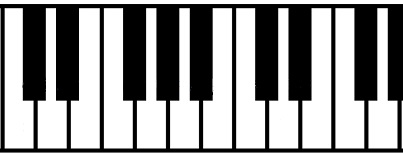
まず鍵盤から覚えましょう。
ピアノには全部で88個の鍵盤があります。(お持ちのピアノやキーボードはもっと少ないかもしれませんが、端から端まで使うようなことはまずありません。ほとんどの楽譜は40鍵盤もあれば演奏することができますので、ご安心ください。)
白い鍵盤は、押されたときに自然できれいな音を作ります。この鍵盤は「白鍵」とよばれます。逆に黒い鍵盤は、「黒鍵」と呼ばれます。
覚える必要はありませんが、英語では白鍵を「ナチュラル」つまり「自然なもの」といい、黒鍵を「アクシデント」つまり「非本質的なもの(音楽用語では臨時音)」と呼ばれます。
鍵盤は白鍵で7つ、黒鍵で5つを1つのくくりとして並んでおり、その並び方を右や左に繰り返してできています。
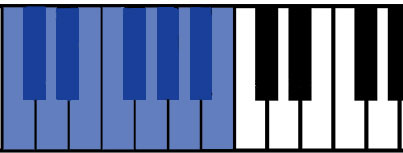
この1つのくくりを「オクターブ」と呼びます。
そのため、図の左の白鍵から1くくり先(右側)の白鍵は「1オクターブ先(右)の鍵盤」と呼ばれます。
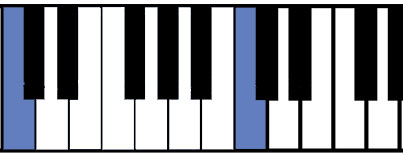
ピアノの鍵盤は右側に行くほど高音を奏で、左側に行くほど低音を奏でていきます。
先程のオクターブで言えば「1オクターブ先の鍵盤」とは「1オクターブ高音の鍵盤」に言い換えられるのです。
②音符と鍵盤の位置
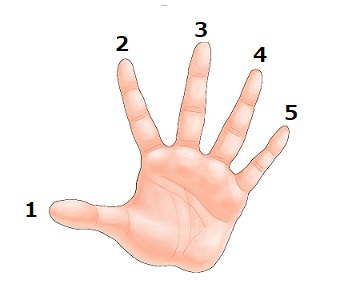
楽譜に書いている音符は鍵盤のどこなのか覚えましょう。
楽譜と鍵盤をつなげるには、まずト音記号とヘ音記号について学ばなければいけません。
こちらの記事を参考にしてください。
実際に鍵盤を押しながら、どこが「ド」の音になるのか調べてみましょう。
単純に場所と「ド」をつなげるだけではダメです。
その鍵盤からなる音をしっかり把握しましょう。
言い換えれば、音を聴いて、それがどこの鍵盤の音になるか、その位置を当てられるようになっておく必要があります。
③姿勢と指の形

次にピアノを弾く姿勢と指の形です。
姿勢と指の形は、「音符がどこの鍵盤にあるか」と同じくらい重要です。
ピアノを弾く姿勢が正しくないと、鍵盤に力がうまく伝わらずに、音の強弱がつけにくくなってしまいます。
それだけではなく、鍵盤の移動、つまり音の移り変わりがぎこちなくなり、いわゆる「初心者の演奏」の典型になってしまいます。
正しい姿勢を学び、鍵盤に力がきれいに伝わるようにしましょう。
間違っても、プロのピアニストがやるように感情を込めて体を倒したりすることは、最初のうちはやってはいけません。
きちんとした姿勢で演奏し、体幹がしっかりと作ることが先決です。
ピアノを弾く姿勢が完璧になれば、今度はピアノを弾く「指の形」です。
こちらも姿勢と同様に、力の伝わり方、そして音の移り変わりに影響してきます。
どうしても初心者の頃は、演奏している間に勝手に指の形が崩れていきがちです。
演奏することに集中しながらも、指の形を意識していきましょう。
これがマスターできていると、今後のピアノ練習の効率がグッと良くなります。
④和音を学ぶ
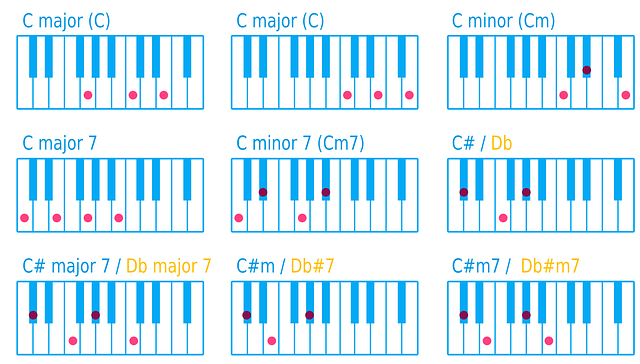
和音はしばしば「コード」とも呼ばれます。
和音とは、3つ以上の音を同時に弾く音のことを言います。
様々な種類がある楽器の中でも1人で和音が演奏できる楽器は少なく、ピアノはその数少ない楽器です。
和音の種類は数学が得意な方なら分かるでしょうが、88鍵盤から選んで弾くわけですから、数え切れないほどの多さがあります。
しかし実際によく使われている和音はそれほど多くありません。
それらは、「メジャーコード」「マイナーコード」として区分されているものです。
こちらの記事でコードを見てみましょう。
コードを幾つか弾いて練習することは大事ですが、同時に聞き取る力を養う必要があります。
楽譜を見て演奏するだけがピアノの演奏ではありません。
自分が聴いていて、気に入った曲をコピーすることも必要です。
このメジャーコードとマイナーコードは、弾くだけでなく、聞き取れるように何度も弾いてみましょう。
⑤簡単な曲を演奏する
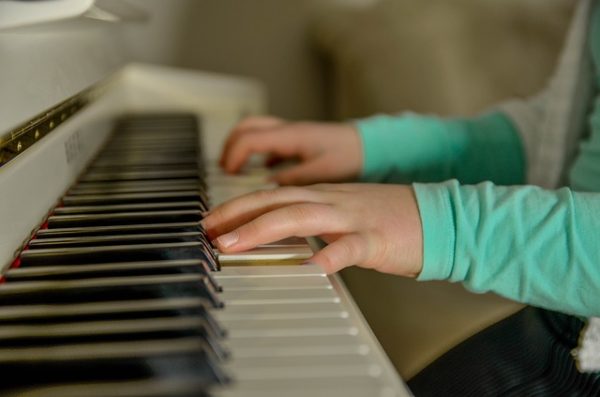
ここまで来たら、簡単な曲を演奏してみましょう。
本来は⑥のトレーニングを先に行うものですが、ピアノを演奏するモチベーションを上げるためにも、この段階で1曲演奏してみることをおすすめします。
ネット上の楽譜や、本に記載しているような楽譜を準備しましょう。
個人的には「きらきら星」がおすすめです。
以下の記事に紹介していますので、参考にされてみてください。もちろん伴奏までついているものです。
楽譜が準備できたら早速練習してみましょう。
まずは片手での練習です。
いきなり演奏できるわけありませんので、まずは、楽譜の音符を確認しながら一つずつ鍵盤を押していきましょう。
鍵盤の位置がわかったら、リズムを意識しながら、通して演奏します。
このとき安定したリズム感を養うために、メトロノームを使うことをおすすめします。
右手の演奏ができるようになったら、左手を同じように練習しましょう。
両方でできれば、今度は両手を同時に演奏します。
片手で演奏するよりも、最初はテンポを落として演奏しましょう。
無理してテンポに合わせて演奏しようとすると、音が一つ外れても気にせずに次に行ってしまうことがあります。
これは練習という意味で良くないやり方です。
確実に1小節ずつ両手でテンポよく演奏していきましょう。
⑥トレーニング

1曲演奏してみたら、自分の指の動きや演奏のどこに苦戦をしたかがわかったと思います。
・鍵盤の移り変わりで指を動かすこと
・左手の小指で鍵盤を押すこと
・和音を弾くこと
・テンポよく演奏すること
・両手で同時に演奏すること
などなど、
個人によって苦手とするところは様々です。
自分が苦手と感じたことを中心にトレーニングしてみましょう。
⑦新しい曲にチャレンジ

⑥のトレーニングを踏まえていれば、新たに曲を演奏する際に、今までよりもスムーズにマスターできるようになるでしょう。
あとはこれを繰り返していくだけです。
曲を練習しては、苦労したところを振り返りトレーニング、また新たな曲を練習していきます。
楽譜の難易度を徐々に上げていくことは理想ですが、あまり意識しすぎては曲が決まりません。
極端に自分のレベルより高い楽譜でなければ、特に難易度を気にせずに、好きな曲・弾いてみたい曲を演奏していきましょう。
ときには自分のレベルよりも難易度が低い楽譜を演奏することも必要です。
難しい楽譜の演奏では見えていなかった、自分の基礎的な部分の弱点が見えてくることがあるからです。
様々な曲を演奏するだけでは、効率的に上達していきません。
必ず振り返り、また自分の演奏を客観的に聞いてみましょう。
得意なスキルは、何もしなくても自然に伸びていきます。
苦手なスキルを意識しながらトレーニングしていきましょう。
自然にあなたは中級者になっているはずです。
コメントを残す